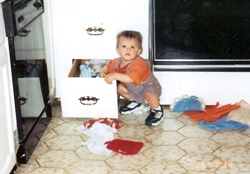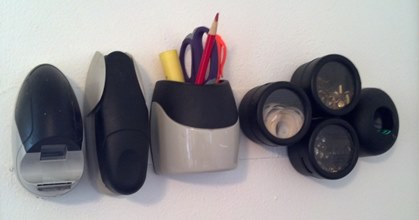An organized homeschool mother is an effective homeschool mother!
Read and Share Your Best Organization Tips Below

Lack of organization leads to frustration and inefficiency. It is true for homeschooling and everything else.
After all, you would likely be unimpressed if you went to your local public school, found the office in disarray, and the secretary had difficulty finding a sharpened pencil. There is one simple, little secret to being organized....
Time
It really is a simple choice:
- 1. Make time up front OR
- 2. Waste time later.
It is the same with homeschool organization. You start the year and each unit by spending time organizing yourself and your schedule and materials. But just like your closet, you'll need to take a little time every week or two to "freshen up" your organization.
Of course, almost all of us will have weeks (or longer) when we get behind. A new baby comes, or your mother-in-law comes, or the consruction crew comes.
Life happens. And it takes its toll on planning and organizing. Don't beat yourself up, just realize the inevitable - but also realise the effect is a temporary decrease in your program's effectiveness. Make it a goal to get re-organized as soon as feasible.
Here's a thought for the time-crunched parent (isn't that all of us) - You can choose to do your planning and organization between OR during your homleschool hours. More tips on that later.
Homeschool Records
Choose your homeschool record keeping system. There are many for purchase. Many full curriculum packages include organized record keeping materials.
You can also develop your own. If you do, make sure you print enough for the quarter, or semester, or year. You don't want to wake up on a Monday morning to find you have no more weekly record sheets and get behind in this department.
Would you like an on-line record keeping system? Tara has developed a free homeschool record keeping program to keep track of grades, events, and allowance.
Some families prefer paper records. www.Design-Your-Homeschool.com specializes in unit-study-friendly record keeping. Their DIY homeschool planner is economical and flexible. Make your life a little easier and have the pages spiral bound.
Clipboard
Here's a tip I read in a homeschool article years ago, and it saved me countless hours. Each child has their own clipboard. Their weekly list of assignments is on the top. Spelling word lists and reading lists are on the clipboard. All unfinished work is on the clipboard. Extra curricular activities, such as soccer schedules, are on the clipboard. Every child has a different colored clipboard, so they can find their own from across the room. When a paper or assignment is completed, it gets moved into their notebook. No more loose papers to lose!
Even in the day where the cell phone seems to be the #1 organizing tool, the humble clipboard still rules. For one thing, we can start teaching our kids to be organized with their papers very early. How early? Will, a lot sooner than we are buying them cell phones. (I hope. Not too many kindergarteners with cell phones, right?)
Second, it has been proven that even in our electronic age we are using plenty of paper. We print the reminders and directions and grades that sent to us electronically. Then we loose them and print them again. Better to have an easy to find place to have all the papers you will need in the next few weeks. And a clipboard is just the answer.
Files, file cabinets, notebooks
Buy or acquire the equipment you will need before getting started. There is no single right way to organize your supplies, but it is right to get the materials you need to stay organized.
You will need a notebook or file organizer for each student to keep their completed assignments in.
A Place for Everything
The kitchen counter and couch may not be the best place to keep books when not in use. Your days will go much smoother if all materials have a place of their own and everyone knows where to find them.
Pencil Sharpener
It may seem like a minor detail, but place your pencil sharpener in a convenient location, but still out of the way of the rest of the household activities. For added convenience, make it near an electrical outlet and a trash can. Assign someone the chore of keeping all the pencils sharpened.
Office Supplies

I highly recommend a "desk set" which includes a tape dispenser (forget those plastic disposables, get the real tape), a stapler, sticky notes, scissors, and paper clips. This may not be on your desk, but in the area you homeschool. I have complete sets in many rooms of our house. You don't have to buy all of it at once. But if you often find you run from the family room to the kitchen for scissors every day, you might want to find a convienent, and aesthetic place in the family room to keep the supplies you often use there.
Curriculum Schedule
So you have acquired your curriculum, and it is all spread out in front of you on the dining room table. You need to plan a master schedule of what books/chapters will be studied at which point in your annual schedule. Many curriculum packages have this as part of their package. In that case, it takes time to become acquainted with their system and how and when they use the different texts.
Weekly Schedule
Each week (or day, or month, depending on your calendar) you need to list the assignments the student needs to complete. Again, this may be included in some curriculum packages. This will be the student's master plan for the week.
Some students like to have all their work "stacked" every morning with the clipboard on top. As each task is completed, it is taken off the stack and one can visually see the day work being done. Other students can get that same effect simply by placing a check mark on the weekly schedule when something is finished.
Evaluating and Grading
After the work is done, it needs to be graded. With some programs, this may be done as the work is being done - such as reading an early reader with a young child. Other assignments are done independently, and can be put aside for the instructor to grade later. Again, having the student leave it on their clipboard, in a folder, in a wallbox outside their bedroom, or other designated place makes it easier for work to be graded at a later time.
Housework
Wouldn't it be nice housework would just "do" itself? Nice dream. But here are some tips that might help:
- Include the students' daily chores on their schedule. You can check both at the same time.
- When mom cleans, everyone else cleans.
- Have a quick "picker-upper" before and after homeschool time.
Laundry
Again, I picked up some great tips from an article years ago, and unfortunately can't give credit to the writer. But her system has worked!- Use hangers for any item that hangs. It is faster to hang then fold.
- Put racks in the laundry room. Every person has his or her own rack. Older kids are expected to take their own laundry to their rooms.
- Hanging most items freed up bedroom space for projects and playing.
- Near or under everyone's clothing rack, place a plastic container for their socks and underwear.
When the School Day Starts Before You Do
 It happened again: On Friday we enthusiastically greet the weekend. "Will plan next week's lesson over the weekend," I think.
It happened again: On Friday we enthusiastically greet the weekend. "Will plan next week's lesson over the weekend," I think. Next thing I know, the alarm clock is ringing Monday morning and I never found a moment to plan. Sound familiar? Check out the article emergency planning: my day started to soon.
About Our Site
Hands-On Learning












